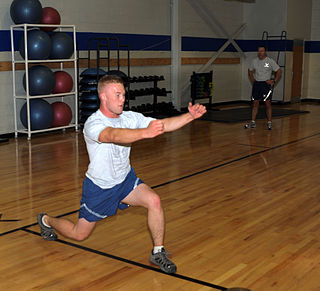This article has multiple issues. Please help improve it or discuss these issues on the talk page . (Learn how and when to remove these template messages)
|
This article has multiple issues. Please help improve it or discuss these issues on the talk page . (Learn how and when to remove these template messages)
|
Jumps are a fundamental part of cheerleading. They are often performed within cheerleading routines to add visual interest, meet a given competition's requirements, and/or score well. [1]
Cheerleading jumps range in difficulty. Basic jumps teach the fundamentals of jumping techniques, proper arm positioning, timing, and safe landings; examples include the “Spread Eagle” and “Tuck Jump." [2] More advanced jumps demand more flexibility, precise technique, and body control; examples include the "Pike" and the "Toe Touch." [1]
In most competitions, jumps are categorized under "tumbling" and judged based on two key aspects: difficulty and execution. Jumps are often performed in combinations to improve a team's score. [1]

A jumping jack, also known as a star jump and called a side-straddle hop in the US military, is a physical jumping exercise performed by jumping to a position with the legs spread wide and the hands going overhead, sometimes in a clap, and then returning to a position with the feet together and the arms at the sides.

A somersault is an acrobatic exercise in which a person's body rotates 360° around a horizontal axis with the feet passing over the head. A somersault can be performed forwards, backwards or sideways and can be executed in the air or on the ground. When performed on the ground, it is typically called a roll.
Because ballet became formalized in France, a significant part of ballet terminology is in the French language.
Trampolining terms are used to describe various positions and types of skill performed in the sport of trampolining.

A handspring is an acrobatic move in which a person executes a complete revolution of the body by lunging headfirst from an upright position into an inverted vertical position and then pushing off from the floor with the hands so as to leap back to an upright position. The direction of body rotation in a handspring may be either forward or backward, and either kind may be performed from a stationary standing position or while in motion.

Yurchenko, also known as round-off entry vaults, are a family of vaults performed in artistic gymnastics in which the gymnast does a round-off onto the springboard and a back handspring onto the horse or vaulting table. The gymnast then performs a salto, which may range in difficulty from a simple single tuck to a triple twist layout. Different variations in the difficulty of the salto lead to higher D-scores. This family of vaults is the most common type of vault in gymnastics and it's named after Natalia Yurchenko, who first performed it in 1982.

A split jump is a sequence of body movements in which a split is performed after jumping, while the performer is still in the air. Split jumps are commonly found in dance, figure skating, and gymnastics, and may also be used as a form of exercise.

A lunge can refer to any position of the human body where one leg is positioned forward with knee bent and foot flat on the ground while the other leg is positioned behind. It is used by athletes in cross-training for sports, by weight-trainers as a fitness exercise, and by practitioners of yoga as part of an asana regimen.

Static trapeze, also known as fixed trapeze, is a type of circus apparatus. In contrast to the other forms of trapeze, static trapeze the bars and ropes mainly stay in place.
The herkie is a cheerleading jump named after Lawrence Herkimer, the founder of the National Cheerleaders Association and former cheerleader at Southern Methodist University. It is similar to a side-hurdler and to the abstract double hook, except instead of the bent leg's knee being pointed downward, it should be flat while the other leg is straight in a straddle jump (toetouch) position.
The following is a glossary of figure skating terms, sorted alphabetically.

The jumping position is a position used by equestrians when jumping over an obstacle, involving a combination of both a "forward seat" and "2 point" position. A rider in jumping position has their body centered over the horse's center of gravity and the saddle. Continuing a line upwards from the stirrup leathers, the head and shoulders fall in front of the line, as do the knees and the hips fall behind it.
Stances are a highly fundamental part of all Chinese Martial Arts. Wushu is characterized by low, wide stances designed for mobility and protection. Stability is another key concern of Chinese martial arts, and the wushu stances reflect this sensibility. There are five key stances utilized in both contemporary wushu and traditional wushu. Many others exist, and different styles of wushu prescribe a particular protocol for "correct" stance.
This is a general glossary of the terms used in the sport of gymnastics.

Bridget Elizabeth Sloan is an American artistic gymnast. She is the 2009 world champion in the all-around, the 2009 United States national champion, and a silver medalist with the American team at the 2008 Summer Olympics in Beijing.
A Basket Toss is a stunt performed in cheerleading using 3 or more bases to toss a flyer into the air. Two of the bases interlock their hands. While in the air, the flyer does some type of jump, ranging from toe-touches to herkies before returning to the cradle.

An acrobatic flip is a sequence of body movements in which a person leaps into the air and then rotates one or more times while airborne. Acrobatic flips are performed in acro dance, free running, gymnastics, cheerleading, high jumping, tricking, goal celebrations and various other activities. This is in contrast to freestyle BMX flips, in which a person revolves in the air about a bicycle.